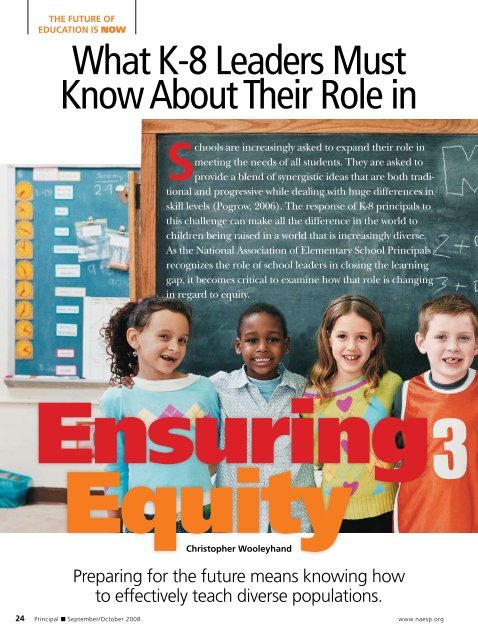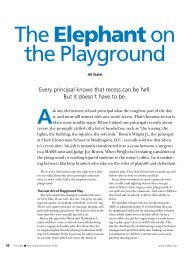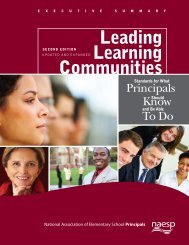What K-8 Leaders Must Know About Their Role in - National ...
What K-8 Leaders Must Know About Their Role in - National ...
What K-8 Leaders Must Know About Their Role in - National ...
Create successful ePaper yourself
Turn your PDF publications into a flip-book with our unique Google optimized e-Paper software.
the future of<br />
education is now<br />
<strong>What</strong> K-8 <strong>Leaders</strong> <strong>Must</strong><br />
<strong>Know</strong> <strong>About</strong> <strong>Their</strong> <strong>Role</strong> <strong>in</strong><br />
Schools are <strong>in</strong>creas<strong>in</strong>gly asked to expand their role <strong>in</strong><br />
meet<strong>in</strong>g the needs of all students. They are asked to<br />
provide a blend of synergistic ideas that are both traditional<br />
and progressive while deal<strong>in</strong>g with huge differences <strong>in</strong><br />
skill levels (Pogrow, 2006). The response of K-8 pr<strong>in</strong>cipals to<br />
this challenge can make all the difference <strong>in</strong> the world to<br />
children be<strong>in</strong>g raised <strong>in</strong> a world that is <strong>in</strong>creas<strong>in</strong>gly diverse.<br />
As the <strong>National</strong> Association of Elementary School Pr<strong>in</strong>cipals<br />
recognizes the role of school leaders <strong>in</strong> clos<strong>in</strong>g the learn<strong>in</strong>g<br />
gap, it becomes critical to exam<strong>in</strong>e how that role is chang<strong>in</strong>g<br />
<strong>in</strong> regard to equity.<br />
Ensur<strong>in</strong>g<br />
Equity<br />
Christopher Wooleyhand<br />
Prepar<strong>in</strong>g for the future means know<strong>in</strong>g how<br />
to effectively teach diverse populations.<br />
24 Pr<strong>in</strong>cipal n September/October 2008<br />
www.naesp.org
Policy and politics are not, nor have<br />
they ever been, the sole driv<strong>in</strong>g force<br />
beh<strong>in</strong>d educational progress for m<strong>in</strong>ority<br />
students. It takes <strong>in</strong>dividual teachers<br />
and adm<strong>in</strong>istrators work<strong>in</strong>g actively and<br />
tirelessly on behalf of students to make<br />
a difference. As S<strong>in</strong>gleton and L<strong>in</strong>ton<br />
(2006) note, educators must have a passion<br />
for address<strong>in</strong>g equity and a will<strong>in</strong>gness<br />
to change. When school leaders<br />
beg<strong>in</strong> to purposefully and thoughtfully<br />
address the needs of all students, they<br />
<strong>in</strong>vest <strong>in</strong> their community. That <strong>in</strong>vestment<br />
pays dividends that can be measured<br />
by both qualitative and quantitative<br />
means.<br />
The importance and value of build<strong>in</strong>g<br />
relationships is recognized as a<br />
critical factor <strong>in</strong> the success of m<strong>in</strong>ority<br />
students. Educators readily agree that<br />
we are charged with establish<strong>in</strong>g and<br />
foster<strong>in</strong>g susta<strong>in</strong>able relationships with<br />
children before we can even hope to<br />
help them (Blankste<strong>in</strong>, 2004). Kuykendall<br />
(2004) calls this “people-oriented<br />
learn<strong>in</strong>g.” School leaders who hope<br />
to reach students from diverse backgrounds<br />
must value their need to be<br />
educated via effective pedagogy. Children<br />
from m<strong>in</strong>ority communities have<br />
the <strong>in</strong>f<strong>in</strong>ite capacity to become lifelong<br />
learners if they can connect with at<br />
least one car<strong>in</strong>g person who is will<strong>in</strong>g to<br />
serve as a positive role model (McNulty<br />
& Quaglia, 2007).<br />
“It takes <strong>in</strong>dividual<br />
teachers and<br />
adm<strong>in</strong>istrators work<strong>in</strong>g<br />
actively and tirelessly<br />
on behalf of students to<br />
make a difference.”<br />
It is the responsibility of K-8 pr<strong>in</strong>cipals<br />
to create model programs at<br />
the elementary and middle levels that<br />
promote and ensure an equitable education<br />
for all. Politicians and school<br />
districts should support these <strong>in</strong>itiatives,<br />
but schools need not wait for fund<strong>in</strong>g<br />
to move forward. School leaders who<br />
accept their responsibility <strong>in</strong> the fight<br />
for equity will work until each student<br />
reaches his or her potential.<br />
Two themes emerge from educational<br />
research that may provide a focus<br />
for K-8 school leaders seek<strong>in</strong>g to ensure<br />
equity. First, specific leadership qualities<br />
enhance and magnify the relationship<br />
between school leaders and student<br />
performance. Second, colleges and<br />
universities are reflect<strong>in</strong>g on leadership<br />
tra<strong>in</strong><strong>in</strong>g and their role <strong>in</strong> ensur<strong>in</strong>g<br />
equal access to education.<br />
Digital Vision/Punchstock<br />
Pr<strong>in</strong>cipal n September/October 2008<br />
25
<strong>Leaders</strong>hip Qualities<br />
While the role of the teacher <strong>in</strong><br />
ensur<strong>in</strong>g equity is undeniable, that<br />
mission can be challeng<strong>in</strong>g if school<br />
leaders, through action or <strong>in</strong>action,<br />
underm<strong>in</strong>e the efforts of teachers.<br />
Therefore, it is critical for school leaders<br />
to possess qualities, and exhibit<br />
behaviors, that are consistent with the<br />
goals of equal access. <strong>Leaders</strong>hip must<br />
ensure that schools are places where<br />
children <strong>in</strong>teract socially, engage <strong>in</strong><br />
recreation, and learn to be compassionate<br />
(Grogan, 2004). In order for school<br />
leaders to understand their role <strong>in</strong> promot<strong>in</strong>g<br />
equity, they must exam<strong>in</strong>e their<br />
own sociopolitical identities with<strong>in</strong><br />
the context of their profession (Evans,<br />
2007). It may also help if they appreciate<br />
the mean<strong>in</strong>g of social justice with<strong>in</strong><br />
the educational context. Social justice<br />
is a process built on respect, care, recognition,<br />
and empathy. It is focused<br />
on reduc<strong>in</strong>g the marg<strong>in</strong>alization and<br />
exclusion of groups. For Theoharis<br />
(2007), social justice leadership means<br />
that pr<strong>in</strong>cipals make issues of race,<br />
class, gender, disability, sexual orientation,<br />
and other historically marg<strong>in</strong>alized<br />
conditions central to their advocacy,<br />
leadership practice, and vision.<br />
School leaders must grasp the complex<br />
role of race and demographic<br />
change <strong>in</strong> their schools. Evans (2007)<br />
uses the term “sensemak<strong>in</strong>g” when discuss<strong>in</strong>g<br />
this concept. She def<strong>in</strong>es<br />
sensemak<strong>in</strong>g as “the cognitive act of<br />
tak<strong>in</strong>g <strong>in</strong> <strong>in</strong>formation, fram<strong>in</strong>g it, and<br />
us<strong>in</strong>g it to determ<strong>in</strong>e actions and behaviors<br />
<strong>in</strong> a way that manages mean<strong>in</strong>g<br />
for <strong>in</strong>dividuals.” Evans also notes that<br />
school leaders must <strong>in</strong>terpret mean<strong>in</strong>g<br />
for themselves before they can shape<br />
and <strong>in</strong>fluence events <strong>in</strong> their schools.<br />
This is a complex and crucial skill for<br />
school leaders motivated by equity<br />
issues. Evans advises that if school leaders<br />
are to address the needs of a racially<br />
diverse student population, they must<br />
acknowledge their own dom<strong>in</strong>ance and<br />
marg<strong>in</strong>alization of others.<br />
Effective school leadership for equity<br />
requires pr<strong>in</strong>cipals to be reflective<br />
of their own personal racial identity.<br />
They must constantly ask themselves<br />
“School leaders who<br />
have a global awareness<br />
might be better able to<br />
challenge the status quo<br />
structure <strong>in</strong> schools.”<br />
how their personal race biases may be<br />
impact<strong>in</strong>g the decision-mak<strong>in</strong>g process.<br />
For school leaders to be effective <strong>in</strong><br />
meet<strong>in</strong>g the needs of m<strong>in</strong>ority students,<br />
they must consider themselves advocates<br />
for all students. Theoharis (2007)<br />
rem<strong>in</strong>ds us that social justice leadership<br />
is what good leadership should be.<br />
Henze (2005) also rem<strong>in</strong>ds us that leaders<br />
must improve their understand<strong>in</strong>g<br />
and knowledge by constantly wear<strong>in</strong>g<br />
their “equity lens,” which will enhance<br />
their ability to promote equity as a consistent<br />
practice.<br />
<strong>Leaders</strong>hip Tra<strong>in</strong><strong>in</strong>g<br />
Recogniz<strong>in</strong>g that effective school<br />
leadership is at the core of equity <strong>in</strong><br />
education, the question becomes how<br />
do we provide tra<strong>in</strong><strong>in</strong>g for adm<strong>in</strong>istrators?<br />
Adm<strong>in</strong>istrators need more than<br />
a cognitive understand<strong>in</strong>g of their sett<strong>in</strong>gs,<br />
they need an emotional understand<strong>in</strong>g<br />
(Grogan, 2004). Henze (2005)<br />
suggests that professional development<br />
for school leaders should address their<br />
awareness of how discourse creates and<br />
re<strong>in</strong>forces ideologies. Henze identifies<br />
the discourse of educational leaders as<br />
a focus for improv<strong>in</strong>g equitable access<br />
to education. She notes that educational<br />
leaders often talk about race and<br />
equity, but suggests that we need to know<br />
how they understand these concepts. She<br />
found that the discourse of educational<br />
leaders is a neglected topic <strong>in</strong> professional<br />
preparation courses. She suggests that<br />
educational leadership programs could<br />
encourage new leaders to use language<br />
more consciously.<br />
There is <strong>in</strong>creas<strong>in</strong>g support for leadership<br />
tra<strong>in</strong><strong>in</strong>g programs that produce<br />
adm<strong>in</strong>istrators who will ensure equitable<br />
results for all students (Lopez, Magdaleno,<br />
& Mendoza Reis, 2006; Henze, 2005;<br />
Theoharis, 2007; Grogan, 2004). As the<br />
K-8 student population becomes <strong>in</strong>creas<strong>in</strong>gly<br />
diverse, a one-size-fits-all approach<br />
is no longer appropriate (Lopez et al.,<br />
2006; Kose, 2007). The preparation of<br />
school leaders thus becomes central <strong>in</strong><br />
the pursuit of equity. The responsibility, <strong>in</strong><br />
many respects, rests with professors of educational<br />
adm<strong>in</strong>istration who must assume<br />
responsibility for leadership programs that<br />
promote equitable results for all students<br />
(Lopez et al., 2006). Grogan (2004) also<br />
suggests that we create professional development<br />
that focuses on ways for adm<strong>in</strong>istrators<br />
to counter the negative effects of<br />
national school reform efforts. She offers<br />
that school leaders should collaborate<br />
with teachers to provide a rich curriculum.<br />
Grogan implores super<strong>in</strong>tendents and<br />
pr<strong>in</strong>cipals to ensure that the remediation<br />
efforts mandated by school reform laws do<br />
not become punitive for students. Evans<br />
(2007) summarizes the concerns related<br />
to school leadership by posit<strong>in</strong>g the need<br />
for school leaders to have a clear and<br />
lucid ideology related to the sociopolitical<br />
issues. School leaders who have a global<br />
awareness might be better able to challenge<br />
the status quo structure <strong>in</strong> schools.<br />
In order for K-8 pr<strong>in</strong>cipals to be the<br />
leaders of change that NAESP’s Vision<br />
2021 <strong>in</strong>itiative calls for, they will need<br />
to become fluent <strong>in</strong> issues associated<br />
with equity. School districts will need to<br />
actively seek out and tra<strong>in</strong> adm<strong>in</strong>istrators<br />
who possess the skills and ability<br />
to advocate for all of their students.<br />
Colleges will be charged with <strong>in</strong>clud<strong>in</strong>g<br />
specific tra<strong>in</strong><strong>in</strong>g that provides budd<strong>in</strong>g<br />
adm<strong>in</strong>istrators with the skills they will<br />
need to elim<strong>in</strong>ate the achievement gap.<br />
If the future of K-8 education is now,<br />
26 Pr<strong>in</strong>cipal n September/October 2008<br />
www.naesp.org
then school leaders will need to make<br />
conscious decisions directed at ensur<strong>in</strong>g<br />
equity for all students. P<br />
Christopher Wooleyhand is pr<strong>in</strong>cipal<br />
of Hillsmere Elementary School <strong>in</strong><br />
Annapolis, Maryland. His e-mail address<br />
is cwooleyhand@aacps.org.<br />
References<br />
Blankste<strong>in</strong>, A. M. (2004). Failure is not an<br />
option. Thousand Oaks, CA: Corw<strong>in</strong><br />
Press.<br />
Evans, A. (2007). School leaders and<br />
their sensemak<strong>in</strong>g about race and<br />
demographic change. Educational<br />
Adm<strong>in</strong>istration Quarterly, 43(2), 159-188.<br />
Grogan, M. (2004). Keep<strong>in</strong>g a critical,<br />
postmodern eye on educational<br />
leadership <strong>in</strong> the United States: In<br />
appreciation of Bill Foster. Educational<br />
Adm<strong>in</strong>istration Quarterly, 40(2), 222-239.<br />
Henze, R. (2005). Metaphors of diversity,<br />
<strong>in</strong>tergroup relations, and equity <strong>in</strong> the<br />
discourse of educational leaders. Journal<br />
of Language, Identity, and Education, 4(4),<br />
243-267.<br />
Web Resources<br />
The Summer 2007 issue of Research<br />
Roundup, titled “Support<strong>in</strong>g Teach<strong>in</strong>g<br />
<strong>in</strong> Culturally Diverse Classrooms,” offers<br />
resources <strong>in</strong>tended to help pr<strong>in</strong>cipals<br />
provide leadership for their teachers’<br />
efforts to reflect on and address issues of<br />
culture and learn<strong>in</strong>g.<br />
www.naesp.org<br />
This paper, “A Collective Responsibility,<br />
A Collective Work,” from the Center<br />
for Law and Social Policy presents<br />
a picture of risk and challenge for<br />
youths <strong>in</strong> distressed communities and<br />
outl<strong>in</strong>es how these communities can<br />
band together to create a cont<strong>in</strong>uum of<br />
supportive activities to bolster children’s<br />
success <strong>in</strong> school and life.<br />
www.clasp.org/publications/<br />
collectiveresponsibility.pdf<br />
Houston, P. D., Blankste<strong>in</strong>, A. M., & Cole,<br />
R. W. (2007). Out-of-the-box leadership.<br />
Thousand Oaks, CA: Corw<strong>in</strong> Press.<br />
Kose, B. W. (2007). One pr<strong>in</strong>cipal’s<br />
<strong>in</strong>fluence on susta<strong>in</strong>ed, systemic, and<br />
differentiated professional development<br />
for social justice. Middle School Journal,<br />
39(2), 34-42.<br />
Kuykendall, C. (2004). From rage to hope.<br />
Bloom<strong>in</strong>gton, IN: Solution Tree.<br />
Lopez, J., Magdaleno, K., & Mendoza<br />
Reis, N. (2006). Develop<strong>in</strong>g leadership<br />
for equity. Educational <strong>Leaders</strong>hip and<br />
Adm<strong>in</strong>istration, 18, 11-19.<br />
McNulty, R. J., & Quaglia, R. J. (2007).<br />
Rigor, relevance and relationships.<br />
School Adm<strong>in</strong>istrator, 64(8), 18-24.<br />
Pogrow, S. (2006). Restructur<strong>in</strong>g highpoverty<br />
elementary schools for success:<br />
A description of the hi-perform school<br />
design. Phi Delta Kappan, 88(3), 223-230.<br />
S<strong>in</strong>gleton, G. E., & L<strong>in</strong>ton, C. (2006).<br />
Courageous conversations about race: A<br />
field guide for achiev<strong>in</strong>g equity <strong>in</strong> schools.<br />
Somerset, NJ: John Wiley & Sons.<br />
Theoharis, G. (2007). Social justice<br />
educational leaders and resistance:<br />
Toward a theory of social justice and<br />
leadership. Educational Adm<strong>in</strong>istration<br />
Quarterly, 43(2), 221-258.<br />
THE EPSON<br />
BRIGHTER FUTURES ®<br />
PROGRAM<br />
INTRODUCES PRINTERS & SCANNERS<br />
The Epson Brighter Futures Program gives you consistent education discounts up to 40% on<br />
select pr<strong>in</strong>ters, projectors, and scanners.<br />
Sign up today to receive program announcements and special promotions on the products<br />
featured here and more!<br />
Epson B-500DN Pr<strong>in</strong>ter Epson B-300 Pr<strong>in</strong>ter Epson WorkForce GT-1500<br />
Document Scanner<br />
Fast, networkable, with<br />
low <strong>in</strong>k cost per page!<br />
<br />
costs less than 1¢/page<br />
for black and 3¢/page<br />
for color*<br />
<br />
enables one pr<strong>in</strong>ter to<br />
serve multiple classrooms,<br />
labs, and offices<br />
<br />
budgets with double<br />
sided pr<strong>in</strong>t<strong>in</strong>g<br />
The high volume, pla<strong>in</strong><br />
paper answer!<br />
<br />
than 1.5¢ for black and 5¢<br />
for color)*<br />
<br />
front paper cassette<br />
<br />
save time and money<br />
Superior image quality plus<br />
enhanced productivity!<br />
<br />
remarkable detail on scans<br />
up to 8.5" x 14"<br />
<br />
document feeder—<br />
up to 20 pages/m<strong>in</strong>ute **<br />
<br />
For more <strong>in</strong>formation contact your Epson Brighter Futures dealer or go to<br />
epsonbrighterfutures.com/5029 | 888.429.3717<br />
Epson, PowerLite, PrivateL<strong>in</strong>e and WorkForce are registered trademarks and Brighter Futures is a service mark of Epson America, Inc. Epson Exceed<br />
Your Vision is a registered logomark, and Exceed Your Vision is a trademark of Seiko Epson Corporation. All other product brand names are trademarks<br />
and/or registered trademarks of their respective companies. Epson disclaims any and all rights to these marks. Copyright 2008 Epson America, Inc.<br />
Product specifications are subject to change without notice.<br />
* Cost per page is derived from <strong>in</strong>k cartridge MSRP divided by cartridge yield. Cartridge yields are approximate based on the ISO/IEC 24711 and 24712 standards for <strong>in</strong>k jet<br />
products, which prescribes cont<strong>in</strong>uous pr<strong>in</strong>t<strong>in</strong>g of a suite of five ISO black-and-color patterns and does not measure yields of the first cartridges (which are used for prim<strong>in</strong>g<br />
the pr<strong>in</strong>ter). Color yield is an average of all three colors. Actual yields depend on specific use. The <strong>in</strong>k cost per page for the B-500DN is based on us<strong>in</strong>g its highest capacity<br />
cartridges. The B-500DN ships with Standard Capacity <strong>in</strong>k cartridges <strong>in</strong>-box. **Based on letter-size scans at 200 dpi <strong>in</strong> Black and white Mode with the default sett<strong>in</strong>g.<br />
RELIABILITY. SUPPORT. SAVINGS.<br />
www.naesp.org Pr<strong>in</strong>cipal n September/October 2008<br />
407-067_BF_Pr<strong>in</strong>cipalMAg_K12_Sept08_YS.<strong>in</strong>dd 1<br />
7/15/08 5:46:36 PM<br />
27

















